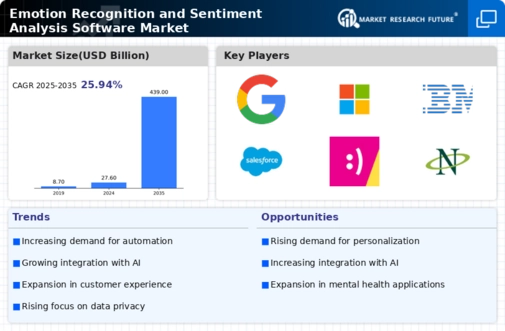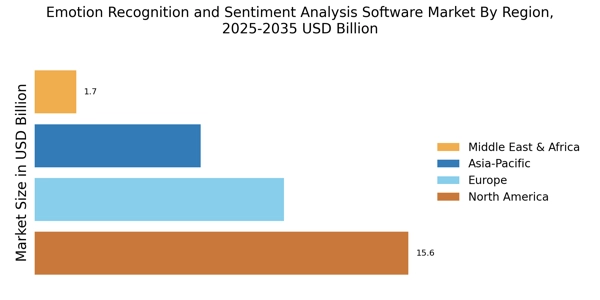Rising Demand for Customer Insights
The Emotion Recognition and Sentiment Analysis Software Market Industry is experiencing a notable surge in demand for customer insights. Businesses are increasingly recognizing the value of understanding consumer emotions and sentiments to enhance customer experiences. According to recent data, companies utilizing sentiment analysis tools report a 20% increase in customer satisfaction. This trend is driven by the need for personalized marketing strategies and improved customer engagement. As organizations strive to remain competitive, the integration of emotion recognition technologies becomes essential. The ability to analyze customer feedback in real-time allows businesses to adapt their strategies swiftly, thereby fostering loyalty and retention. Consequently, the demand for sophisticated emotion recognition and sentiment analysis software is expected to grow, as companies seek to leverage data-driven insights to inform their decision-making processes.
Advancements in AI and Machine Learning
Technological advancements in artificial intelligence and machine learning are significantly influencing the Emotion Recognition and Sentiment Analysis Software Market Industry. These innovations enable more accurate and efficient analysis of emotional data, allowing businesses to derive actionable insights from vast amounts of unstructured data. The integration of deep learning algorithms has improved the accuracy of sentiment analysis, with some systems achieving over 90% accuracy in emotion detection. As organizations increasingly adopt AI-driven solutions, the market for emotion recognition software is projected to expand. This growth is further fueled by the rising availability of large datasets, which enhance the training of machine learning models. Consequently, businesses are more inclined to invest in advanced sentiment analysis tools to gain a competitive edge in understanding consumer behavior.
Growing Importance of Social Media Monitoring
The growing importance of social media monitoring is a key driver for the Emotion Recognition and Sentiment Analysis Software Market Industry. With the proliferation of social media platforms, businesses are inundated with vast amounts of user-generated content. This content serves as a rich source of emotional data that can be analyzed to gauge public sentiment towards brands and products. Recent studies indicate that 70% of consumers express their opinions on social media, making it imperative for companies to monitor these sentiments. By employing sentiment analysis software, organizations can identify trends, manage their online reputation, and respond proactively to customer feedback. This proactive approach not only enhances brand loyalty but also informs product development and marketing strategies. As a result, the demand for emotion recognition tools that can effectively analyze social media sentiment is on the rise.
Increased Focus on Mental Health and Well-being
An increased focus on mental health and well-being is emerging as a significant driver for the Emotion Recognition and Sentiment Analysis Software Market Industry. Organizations are recognizing the importance of employee well-being and are leveraging sentiment analysis tools to monitor workplace emotions. By analyzing employee feedback and sentiments, companies can identify potential issues and foster a healthier work environment. This trend is particularly relevant in sectors such as healthcare and education, where understanding emotional states can lead to improved outcomes. The market for emotion recognition software is likely to expand as organizations seek to implement solutions that promote mental health initiatives. Furthermore, the integration of these tools into employee engagement platforms is expected to enhance overall workplace satisfaction and productivity.
Regulatory Compliance and Data Privacy Concerns
Regulatory compliance and data privacy concerns are increasingly shaping the Emotion Recognition and Sentiment Analysis Software Market Industry. As data protection regulations become more stringent, organizations must ensure that their sentiment analysis practices comply with legal standards. This has led to a growing demand for software solutions that prioritize data privacy while still delivering accurate emotional insights. Companies are seeking tools that not only analyze sentiments but also adhere to regulations such as GDPR and CCPA. The emphasis on ethical data usage is likely to drive innovation in the market, as developers create solutions that balance compliance with functionality. Consequently, the Emotion Recognition and Sentiment Analysis Software Market is expected to evolve, with a focus on transparency and user consent in data collection and analysis.


















Leave a Comment